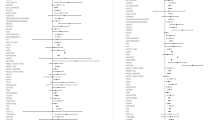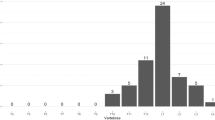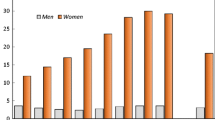Conclusions
The EVOS study has been an extremely fertile source of ideas and has tended to support a number of hypotheses concerning the importance of physical activity, trauma, sex hormone status, alcohol consumption and, above, all relative body weight (expressed as BMI) as direct or indirect determinants of incident vertebral fractures. However, a prevalence study cannot establish how many deformities were due to osteoporosis nor when they occurred. The forthcoming results of the EPOS vertebral incidence study will allow most or all of these ideas to be tested. With measurements of bone density, biomarkers and even bone histology [30] in some subjects EPOS should be well equipped to address questions relating risk factors for fracture to postulated biological mechanisms.
Similar content being viewed by others
References
Cooper C. Epidemiology and public health impact of osteoporosis. In: Reid D (ed) Baillière’s clinical rheumatology, vol 7. London: Baillière Tindall, 1993:3.
Spector TD, Cooper C, Lewis AF. Trends in admission for hip fracture in England and Wales, 1968–1985. BMJ 1990; 300:173–4.
Bengner U, Johnell O, Redlund-Johnell I. Changes in incidence and prevalence of vertebral fractures during 30 years. Calcif Tissue Int 1988;42:293–6.
Fujiwara S, Mizuno S, Ochi Y, et al. The incidence of thoracic vertebral fractures in a Japanese population. J Clin Epidemiol 1991;44:1007–14.
Melton L, III. Hip fractures: a worldwide problem today and tomorrow. Bone 1993; 14:S 1–8.
Elffors I, Allander E, Kanis JA, et al. The variable incidence of hip fracture in Southern Europe: the MEDOS Study. Osteoporos Int 1994;4:253–63.
Silman AJ, on behalf of the European Vertebral Osteoporosis (EVOS) Group. The European Vertebral Osteoporosis Study (EVOS). In: Christiansen C, Riis B (eds) Osteoporosis: proceedings of the IVth international symposium on osteoporosis and consensus development. Hong Kong, 1993:65-6.
Reeve J, on behalf of the EPOS Study Group. The European Prospective Osteoporosis Study. Osteoporos Int 1996; (Suppl 3):S 16–9.
Eastell R, Cedel SL, Wahner HW, Riggs BL, Melton LJ III. Classification of vertebral fractures. J Bone Miner Res 1991;6:207–15.
McCloskey EV, Spector TD, Eyres KS, et al. The assessment of vertebral deformity: A method for use in population studies and clinical trials. Osteoporos Int 1993;3:138–17.
O’Neill TW, Varlow J, Felsenberg D, et al. Variation in vertebral height ratios in population studies. J Bone Miner Res 1994;9:1895–907.
O’Neill TW, Cooper C, Algra D, et al. Design and development of a questionnaire for use in a multicentre study of vertebral osteoporosis in Europe: the European Vertebral Osteoporosis Study (EVOS). Rheumatol Eur 1995;24:75–81.
O’Neill TW, Marsden D, Matthis C, Raspe H, Silman AJ, on behalf of the European Vertebral Osteoporosis Study (EVOS) group. Survey response rates — national and regional differences in a European multicentre study of vertebral osteoporosis. J Epidemiol Community Health 1995;49:87–93.
O’Neill TW, Marsden D, Silman AJ, on behalf of the European Vertebral Osteoporosis Study Group. Differences in the characteristics of responders and nonresponders in a prevalence survey of vertebral osteoporosis. Osteoporos Int 1995;5:327–34.
O’Neill TW, Cooper C, Cannata JB, et al. Reproducibility of a questionnaire on risk factors for osteoporosis in a multicentre prevalence survey: the European Vertebral Osteoporosis Study. Int J Epidemiol 1994;23:559–65.
O’Neill TW, Felsenberg D, Varlow J, et al. The prevalence of vertebral deformity in European men and women: the European Vertebral Osteoporosis Study. J Bone Miner Res 1996; 11:1010–7.
Johnell O, O’Neill T, Felsenberg D, et al. Anthropometric measurements and vertebral deformities. Am J Epidemiol 1997; (in press).
O’Neill TW, Silman AJ, Naves Diaz M, et al. Influence of hormonal and reproductive factors on the risk of vertebral deformity in European women. Osteoporos Int 1997;7:72–8.
Silman A, O’Neill T, Cooper C, Kanis J, Felsenberg D, the EVOS Study Group. Influence of physical activity on vertebral deformity in men and women: results from the European Vertebral Osteoporosis Study. J Bone Miner Res 1997;12:813–9.
Naves Diaz M, O’Neill T, Silman A, the EVOS Study Group. The influence of alcohol consumption on the risk of vertebral deformity. Osteoporos Int 1997;7:65–71.
Naves Diaz M, O’Neill T, Silman A, the EVOS Study Group. The influence of family history of hip fracture on the risk of vertebral deformity in men and women: the European Vertebral Osteoporosis Study. Bone 1997;20:145–9.
Dequeker J, Reeve J, Pearson J, et al. Multicentre European COMAC-BME study on the standardisation of bone densitometry procedures. Technol Health Care 1993;1:127–31.
Pearson J, Dequeker J, Reeve J, et al. Dual X-ray absorptiometry of the proximal femur: normal European values standardised with the European Spine Phantom. J Bone Miner Res 1995;10:315–24.
Pearson J, Dequeker J, Henley M, et al. European semi-anthropomorphic spine phantom for the calibration of bone densitometers: assessment of precision, stability and sccuracy. Osteoporos Int 1995;5:174–84.
Dequeker J, Pearson J, Reeve J, et al. Dual X-ray absorptiometry: cross-calibration and normative reference ranges for the spine: results of a European Community Concerted Action. Bone 1995; 17:247–54.
Lunt M, Felsenberg D, Adams J, et al. Population-based geographic variations in DXA bone density in Europe: the EVOS study. Osteoporos Int 1997;7:175–189.
WHO Study Group. Assessment of fracture risk and its application to screening for postmenopausal osteoporosis. WHO technical report, No 843. Geneva: World Health Organization, 1994.
Lunt M, Felsenberg D, Reeve J, et al. Bone density variation and its effects on risk of vertebral deformity in men and women studied in 13 European centres: the EVOS Study. J Bone Miner Res 1997; 12 (in press).
O’Neill T, Lunt M, Felsenberg D, et al. The choice of algorithm for evaluating spine deformities from 6 point placements: use of DXA densitometry as a referent. Calcif Tissue Int 1995;56:496.
Bell K, Garrahan N, Kneissel M, et al. Cortical and cancellous bone in the human femoral neck: evaluation of an interactive image analysis system. Bone 1996;19:541–8.
Author information
Authors and Affiliations
Consortia
Additional information
Members of the EPOS Study Group:Project Coordinators: Dr. J. Reeve and Professor A. J. Silman.Other Principal Investigators: Dr. K. Abendroth, Friedrich Schiller Universität, Jena, Germany; Professor C. Gennari, Universita degli Studi di Siena, Siena, Italy; Professor D. Banzer, Krankenhaus Behring, Berlin, Germany; Professor L. I. Benevolenskaya, Institute of Rheumatology of RAMS, Moscow, Russia; Dr. A. Bhalla, Royal National Hospital for Rheumatic Diseases, Bath, UK; Dr. G. Bréart, INSERM U. 149, Paris, France; Dr. J. Bruges Armas, Hospital de Santo Espirito do Angra do Heroismo, Azores, Portugal; Professor J. B. Cannata, Hospital Central de Asturias, Oviedo, Spain; Professor C. Cooper, MRC Epidemiology Unit, Southampton, UK; Professor P. D. Delmas, INSERM U. 403, Lyon, France; Professor Dr. J. DeQueker, Universitaire Ziekenhuizen Leuven. Leuven, Belgium; Professor G. Dilsen, Fizik Tedavi ve Rehabilitasyon Bolumu, Istanbul, Turkey; Professor E. K. Dretakis, University General Hospital, Heraklion, Greece; Dr. O. Ershova. Yaroslavl Medical Academy, Yaroslavl, Russia; Dr. J. A. Falch, Aker Hospital, Oslo, Norway; Dr. B. Felsch, Klinik für Innere Medizin, Jena, Germany; Professor D. Felsenberg, Freie Universität Berlin, Germany; Professor F. Galan Galan, University of Seville, Seville, Spain; Professor S. Havelka, Institute of Rheumatology, Prague, Czech Republic; Dr. K. Hoszowski, PKP Hospital, Warsaw, Poland; Professor I. Jajic, Clinical Hospital ‘Sestre milosrdnice’, Zagreb, Croatia; Professor O. Johnell, Malmö General Hospital, Malmö, Sweden; Professor K.-T. Khaw, Addenbrooke’s Hospital, Cambridge, UK; Professor J. Kanis, University of Sheffield, Sheffield, UK; Dr. U. Kragl, Klinik für Orthopädie, Erfurt, Germany; Dr. H. Kröger, Kuopio University Hospital, Kuopio, Finland; Dr. P. Lips, VU Academisch Ziekenhuis, Amsterdam, Netherlands; Professor A. Lopes Vaz, Hospital de S. Joao, Oporto, Portugal; Professor R. S. Lorenc, Children’s Health Centre, Warsaw, Poland; Professor G. Lyritis, University of Athens, Athens, Greece; Dr. F. Marchand, Centre de Médecine Spécialisée Claud Gauthier, Montceau, France; Dr. P. Masaryk, Research Institute of Rheumatic Diseases, Piestany, Slovakia; Dr. T. Miazgowski, Akademii Medyznej, Szczecin, Poland; Dr. J. Nijs, KV Leuven, Leuven, Belgium; Dr. T. O’Neill, University of Manchester ARC Epidemiology Research Unit, Manchester, UK; Professor R. Pérez Cano, University of Seville, Seville, Spain; Dr. H. A. P. Pols, Erasmus University Medical School, Rotterdam, Netherlands; Dr. G. Poor, National Institute of Rheumatology, Budapest, Hungary; Dr. A. Rapado, Fundacion Jiminez Diaz, Madrid, Spain; Professor H. Raspe, MU Lïbeck, Lübeck, Germany; Dr. D. M. Reid, University of Aberdeen, Aberdeen, UK; Professor W. Reisinger, Bereich Medizin (Charité), Berlin Charité, Germany; Professor H. Schatz, Medizinische Klinik und Poliklinik, Bochum, Germany; Dr. C. Scheidt-Nave, Medizinische Klinik & Poliklinik, Heidelberg, Germany; Professor M. Sosa, Universidad de Las Palmas de Gran Canaria, Spain; Professor J. Stepan, Charles University Faculty of Medicine 1, Prague, Czech Republic; Dr. C. Todd, University Department of Community Medicine, Cambridge, UK; Dr. K. Weber, Medizinische Universitätklinik, Graz, Austria; Dr. A. Woolf, City Hospital, Truro, UK.
Rights and permissions
About this article
Cite this article
Reeve, J., Silman, A. & EPOS Study Group. Epidemiology of osteoporotic fractures in Europe: Towards biologic mechanisms. Osteoporos Int 7 (Suppl 3), 78–83 (1997). https://doi.org/10.1007/BF03194348
Issue Date:
DOI: https://doi.org/10.1007/BF03194348




